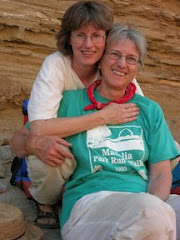 |
| The Victorious Youth |
The Victorious Youth is one of the most stunning Greek, Roman, and Etruscan works at the sumptuous Getty Villa in Malibu, CA. Situated on 64 acres overlooking the Pacific Ocean, the museum is a re-creation of a first-century Roman country house that was buried when Vesuvious erupted.
 |
| Getty villa peristyle with shaded walkways and pool |
 |
| 1st century mummy of Herakleides |
Even more unusual are the tombstones depicting the deceased interacting with their families, something we've never seen before in any cemetery or museum in any country. One shows an older couple talking to their son. The father seems to be making a point, perhaps giving some final advice to his heir. But the young man is not looking at his father. He and his mother gaze into each other's eyes, their hands joined.
Another tombstone, made in Athens in 400 BCE, depicts a man with his battle shield and helmet, perhaps indicating that he died in battle. He seems to be shaking his wife's hand. According to the names on the headstone, this is Philoxenos and Philoumene, their final farewell etched in perpetuity.
As more people today are choosing green burials, which require no headstones, perhaps contemporary cemeteries could recoup that lost business by reviving the ancient practice of carving enduring family portraits in marble!
Nancy Manahan





No comments:
Post a Comment